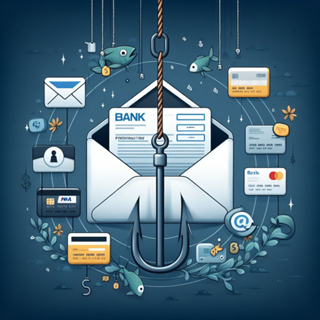What Are Phishing Attacks?
(See also About email security)
Phishing attacks are a type of cyber attack where perpetrators masquerade as trustworthy entities to deceive individuals into divulging sensitive information such as usernames, passwords, credit card details, or other personal data. These attacks often occur through fraudulent emails, text messages, or instant messages that appear to be from legitimate sources like banks, social media platforms, or government agencies.

Types of Phishing Attacks
- Email Phishing: The most common form of phishing involves sending deceptive emails that appear to come from reputable organizations. These emails typically contain urgent messages, alarming statements, or enticing offers to prompt recipients to click on links or download attachments.
- Spear Phishing: This is a more targeted form of phishing where attackers customize their messages for specific individuals or organizations. They gather information about their targets from sources like social media or corporate websites to make their emails seem more convincing.
- Smishing and Vishing: Phishing attacks can also occur via SMS (smishing) or voice calls (vishing). In these scenarios, attackers use text messages or phone calls to trick individuals into revealing sensitive information or visiting malicious websites.
- Pharming: Pharming involves redirecting users from legitimate websites to fraudulent ones without their knowledge. Attackers achieve this by tampering with DNS (Domain Name System) settings or exploiting vulnerabilities in routers or DNS servers.
- Phishing Techniques: Phishing attacks often employ various techniques to trick users, including creating fake login pages, using urgency or fear tactics, impersonating trusted contacts, and spoofing email addresses or URLs to mimic legitimate domains.
Consequences of Phishing Attacks
Falling victim to a phishing attack can have severe and far-reaching consequences, affecting both individuals and organizations. Here are some of the most significant outcomes:
- Identity Theft: Phishing attacks are often designed to steal personal information, such as Social Security numbers, addresses, or credit card details. Once attackers obtain this data, they can assume the victim's identity, committing fraud by opening new credit accounts, taking out loans, or even filing false tax returns in the victim's name. Recovering from identity theft can take years and requires significant effort to restore financial and personal records.
- Financial Losses: Financial losses from phishing attacks can occur on both a personal and corporate scale. Attackers may siphon funds from bank accounts, conduct fraudulent transactions, or make unauthorized purchases using stolen credit card information. In some cases, businesses lose substantial sums through "business email compromise" (BEC) schemes, where phishing attackers trick employees into transferring large amounts of money into fraudulent accounts. The FBI estimates billions of dollars in losses each year due to phishing-related fraud.
- Unauthorized Access to Accounts: When phishing attacks succeed in stealing login credentials, attackers can gain unauthorized access to accounts, including email, financial services, or internal corporate systems. From there, they may manipulate data, steal sensitive information, or engage in further fraudulent activities. For organizations, this can result in compromised customer data, intellectual property theft, and disruption of operations. Account takeovers also pose significant risks to personal privacy, as attackers can monitor emails, messages, and other communications.
- Malware Infections: Many phishing attacks aim to distribute malware, which can have devastating effects on individual devices and corporate networks. Clicking on malicious links or downloading infected attachments can lead to the installation of ransomware, spyware, or keyloggers. Ransomware can encrypt critical data and demand a payment for its release, crippling businesses. Spyware and keyloggers can silently monitor user activity, capturing everything from passwords to sensitive company information.
- Reputational Damage: For organizations, falling victim to a phishing attack can significantly damage their reputation. Customers, partners, and stakeholders may lose trust in a company's ability to safeguard sensitive data, especially if personal or financial information is leaked. High-profile data breaches often make headlines, tarnishing a company's image and leading to customer attrition. The reputational fallout can be long-lasting and difficult to recover from, affecting stock prices, market competitiveness, and customer loyalty.
- Legal and Regulatory Consequences: Organizations that fail to protect their customers from phishing attacks may face legal repercussions. Regulatory bodies often impose strict data protection standards, such as GDPR in Europe or HIPAA in the United States. A failure to prevent phishing attacks that lead to data breaches can result in hefty fines and legal actions, compounding the financial damage. Victims of phishing may also sue companies for negligence if they feel their data was not properly protected.
High-Profile Phishing Cases
Several high-profile cases that were the result (at least partially) of this kind of attacks highlight the devastating consequences they can have:

- The Podesta Emails (2016): A phishing attack targeted John Podesta, chairman of Hillary Clinton's presidential campaign, resulting in the compromise of thousands of private emails. The leak of these emails had a profound impact on the 2016 U.S. presidential election, influencing public opinion and fueling political controversies.
- 2017 Equifax Data Breach: While phishing wasn't the sole cause, it played a role in this massive data breach that exposed the personal information of over 147 million Americans. The breach led to widespread identity theft concerns, lawsuits, and a significant loss of consumer trust.
- The RSA Hack (2011): A phishing attack targeting RSA employees led to the compromise of its SecureID tokens, which are widely used for two-factor authentication by government agencies and corporations. The attackers gained access to sensitive data, resulting in widespread security concerns across multiple industries.
- Sony Pictures Hack (2014): A spear-phishing attack against Sony Pictures employees gave hackers access to sensitive internal communications and confidential information. The attackers leaked unreleased films, internal emails, and sensitive employee data, severely damaging Sony's reputation and operations.
These examples illustrate how phishing attacks can lead to a domino effect, impacting not just the immediate victim but also broader political, economic, and social landscapes. Organizations must take proactive measures to defend against phishing attacks, as the potential consequences are increasingly significant in today's interconnected world.
Weak Passwords and Phishing
Phishing attacks can exploit weak passwords as part of their strategy to gain unauthorized access to accounts or sensitive information. Here's how:
- Brute Force Attacks: While not directly related to phishing, weak passwords can make accounts vulnerable to brute force attacks, where attackers systematically try different password combinations until they find the correct one. Phishing attacks can be used in conjunction with or as a precursor to brute force attacks if initial attempts to trick users into revealing their passwords are unsuccessful.
- Credential Reuse: Many people use the same password across multiple accounts for convenience. If attackers obtain login credentials through phishing, they may try to reuse those credentials to access other accounts belonging to the same individual. This underscores the importance of using unique, strong passwords for each online account.
- Account Takeover: Once attackers gain access to an account, they can carry out various malicious activities, such as stealing sensitive information, sending spam or phishing emails to contacts, spreading malware, or conducting fraudulent transactions. Strong passwords serve as a crucial line of defense against unauthorized access and mitigate the risk of account takeover resulting from phishing attacks.
Tools and Services to Protect Against Phishing Attacks
To defend against phishing attacks, there are several tools and services designed to identify, block, and mitigate the risks. Here are some key solutions from companies and service providers:
- Proofpoint (Email Security): Proofpoint provides comprehensive email security solutions designed to detect and block phishing emails, malware, and other threats. Their advanced machine learning algorithms scan emails for suspicious content, preventing phishing attacks from reaching users.
- Mimecast (Targeted Threat Protection): Mimecast offers a suite of tools for email and web security, with targeted threat protection against phishing, spear phishing, and impersonation attacks. Mimecast scans attachments, links, and content in real-time, reducing the risk of employees clicking on malicious links.
- Barracuda (Phishing and Impersonation Protection): Barracuda's email protection services use artificial intelligence (AI) to block phishing emails and impersonation attempts. Their tools analyze email metadata, communication patterns, and language to detect and prevent attacks before they reach the recipient.
- Google Safe Browsing (Web Filtering): Google Safe Browsing protects users by warning them when they try to visit known phishing or malware-infected websites. Integrated into Chrome and other browsers, this service identifies malicious websites and alerts users before they can input sensitive information.
- Microsoft Defender for Office 365 (Advanced Threat Protection): Microsoft Defender for Office 365 offers advanced email filtering and protection for Microsoft users. It scans emails for phishing attempts, unsafe attachments, and malicious URLs, ensuring phishing attacks are blocked before they reach an employee's inbox.
- LastPass (Password Manager): LastPass is a password manager that helps users create and store strong, unique passwords for each online account. By generating complex passwords, users reduce the risk of phishing-related credential reuse. LastPass also offers secure password sharing and two-factor authentication (2FA) integration.
- Duo Security (Multi-Factor Authentication): Duo Security, part of Cisco, provides multi-factor authentication (MFA) solutions to add an extra layer of protection. Even if attackers obtain login credentials via phishing, Duo's MFA requires an additional verification step, blocking unauthorized access.
- PhishMe (Security Awareness Training): PhishMe, now part of Cofense, offers phishing simulation and security awareness training. By simulating real phishing attacks, organizations can test employees' responses and provide educational feedback to improve awareness and help users recognize phishing attempts in real-world scenarios.
- KnowBe4 (Security Awareness Platform): KnowBe4 is a security awareness training platform that specializes in phishing education. It helps train employees on how to spot phishing emails and offers simulated phishing attacks to gauge user responses. This proactive approach educates users on avoiding phishing risks.
- ZeroFox (Digital Risk Protection): ZeroFox provides digital risk protection, focusing on social media and external digital platforms where phishing attacks might originate. Their tools monitor for phishing threats and impersonations across social media, websites, and other online channels, ensuring quick identification and remediation of phishing attempts.
Conclusion
Phishing attacks remain a serious cybersecurity threat to both individuals and organizations. However, with the right tools and services, the risks can be significantly minimized. Also, to prevent phishing attacks, individuals and organizations should educate themselves and their employees about recognizing phishing attempts, use security tools like spam filters and antivirus software, verify the legitimacy of emails and websites, avoid clicking on suspicious links or downloading attachments from unknown sources, and implement multi-factor authentication for added security. While strong passwords alone cannot prevent phishing attacks, they play a vital role in overall cybersecurity by reducing the likelihood of successful account compromise in the event of a phishing attempt. Additionally, practicing good password hygiene, such as regularly updating passwords, using complex combinations of characters, and avoiding password reuse, can further enhance protection against phishing and other cyber threats.


